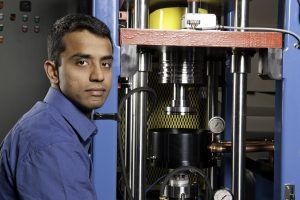In developing a new methodology, it was essential to increase the intensity of testing without altering failure mode – the accurate measure of the wear of the plastic. Many existing methods currently in use confuse wear failure with the creep, or melting, of plastic.
Freudenberg Sealing Technologies began work in 2016 on the development of new test methods for HPPs. The company’s customers – in the automotive, aerospace, marine, rail, commercial truck and bus, construction and agricultural industries, among others – were all exploring the use of HPPs in powertrain and hydraulic systems to solve a variety of environmental and performance challenges. Scientists worked closely with material engineers to study the test methods being used in the U.S., Germany and Japan. By extracting and combining critical processes from these methods, Freudenberg developed a new approach to test Plastic Materials.
The methodology delivers reliable, accurate, real-world results in a fraction of the time normally required for traditional HPPs testing. When the automotive OEM working on transmissions approached the company about HPPs compatibility with softer metal shafts, the company was able to identify an optimal solution within days, not weeks, of the request.
Why it’s better
While faster is important – reducing testing time from five days to four hours, allowing for two tests per day – so is test accuracy. The HPPs test methodology that was developed generates extremely accurate component performance data under real application conditions.
Wear and friction characterization of HPPs is complicated because they are dependent upon a number of system parameters including loads, speeds, temperatures, roughness/hardness, material geometry and others, which can change significantly based on application. Accurate evaluation of tribological performance of HPPs needs to account for these variables, as recommended in this innovative methodology, enabling it to be predictive of part performance.
Environmental advantages
This improved test methodology facilitates real environmental advantages as well. A recent study published by Holmberg and Erdemir (Ref. 2) on the effect of friction and wear on energy consumption, economic expenditure, and CO2 emissions, concluded that 23 percent of the world’s total energy consumption in the transportation, manufacturing, power generation and residential sectors results from tribological contacts.
Through the appropriate application of tribological technologies, CO2 emissions and the related economic costs could be significantly reduced – with those improvements underpinned by more accurate testing and reliable results. As shown in the application example in the figure below, changing material essentially reduced friction by a factor of 2.2 or approximately 55 percent. This means that the Co2 emissions are proportionally reduced by about 55 percent at that specific component in the transmission. Note, however, that this does not mean that the CO2 footprint of the entire transmission is reduced by 55 percent, as there are several components with frictional losses in the transmission.
Existing and commonly used tribological testing methodologies often fall short of the needs of OEMs and their customers. This innovative approach in testing saves manufacturers time through accelerated product development cycles, improved industry performance and numerous environmental improvements. It’s good for manufacturers, good for the industry and good for the world.
References1. Sundararaman, S., “Improved Test Method for Tribological Evaluation of High-Performance Plastics,” SAE Technical Paper 2019-01-0183, 2019, doi:10.4271/2019-01-0183.
2. Holmberg, K., and Erdemir, A., “Influence of Tribology on Global Energy Consumption, Costs and Emissions,” Friction, Vol. 5, No. 3, pp. 263 – 284, 2017.




